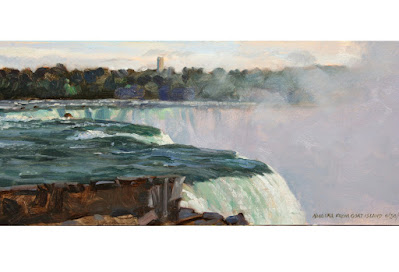A few days ago, in a previous post, I shared some of the preliminary sketches for the establishing shots of Waterfall City (below).
Waterfall City (1988), and Waterfall City: Afternoon Light (2002)
But there's only so much I can do from my imagination alone. To go beyond that, I have to "fill the bucket," which is what I call the process of gathering reference. One key step was painting at Niagara Falls.
I set up my painting gear on Goat Island with a bunch of kids watching. The studies help me understand how the water should look, something that's hard to get from photos.
The following clip is from a documentary I produced about the making of Dinotopia.
Here's the full production if you haven't seen it.
In a schematic maquette, you don’t have to sculpt every single building, just a few characteristic geometric forms. By looking at photos of those representative forms as you do your drawing, you can add details and multiply them into the full city.
The real benefit of such a schematic maquette is that you can swing it around at any angle and see how the light plays on it. This kind of model is a great help for entertainment designers or sequential artists who need to imagine a complex form consistently from a variety of angles.
I also built a more detailed maquette. This maquette is made from cardboard, styrofoam, and epoxy putty.
It helped me imagine perspective and lighting on this near corner of Waterfall City, which appeared from many angles in The World Beneath and Journey to Chandara.
After studying the maquettes, I draw a tone paper study and do a small oil sketch to solidify my vision of how the city will look veiled in mist.







تعليقات
إرسال تعليق